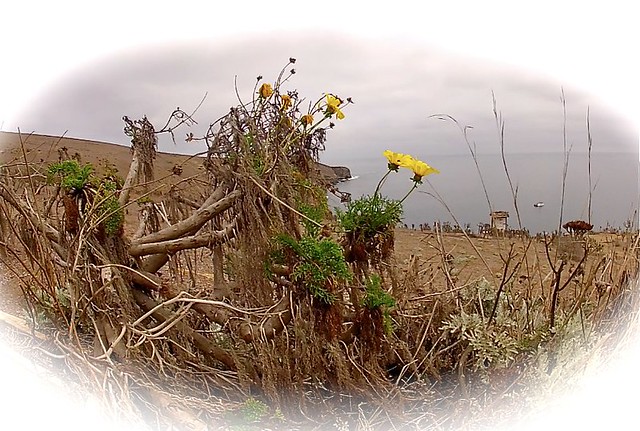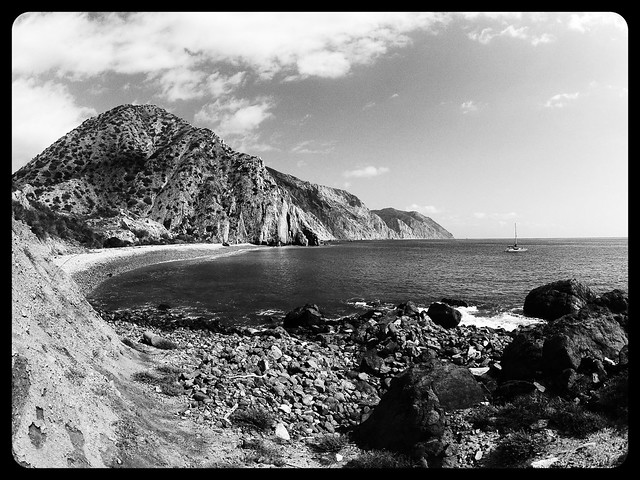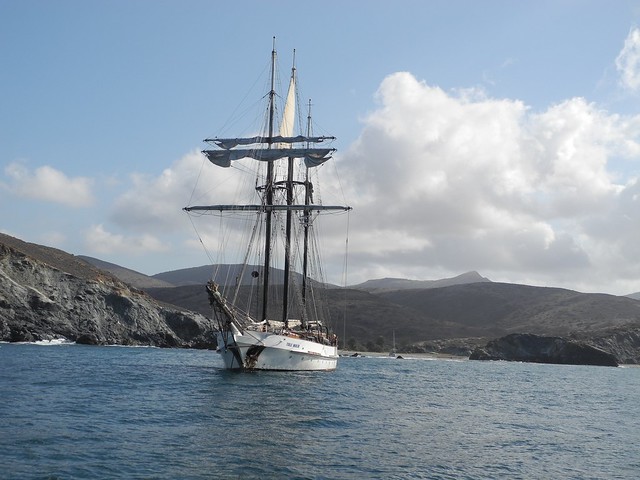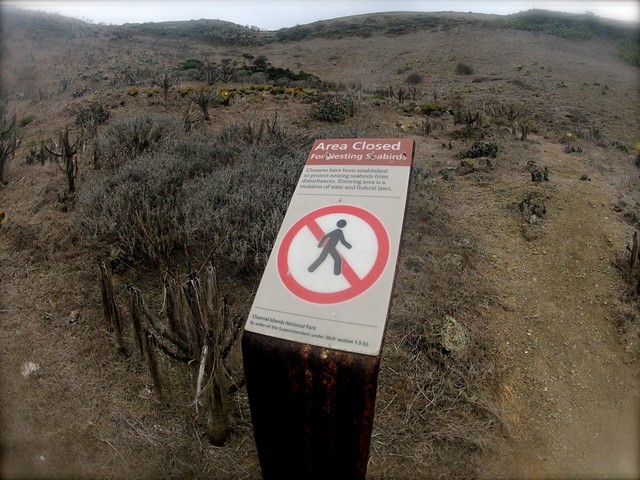"HELLO." I called out, a little nervous that I might get kicked off the island.
Pete had long hair and a maroon sweatshirt. He regarded me with suspicion, explaining the facility was closed (due to the government shutdown). Luckily, the Pygmy Mammoth charmed him, and he decided to give me a short tour.

Pete is a contractor for native plant restoration on Santa Barbara island. "All the plants look dry and dead, but they are just hibernating." He explained, spanning his arm around the landscape.
Then he pointed to a green patch with yellow flowers below the nursery. "Except right below the nursery irrigation, where the Giant Coriopsis are constantly blooming."
Giant Cori-op-sis… I rolled the name in my tongue. It sounded like (and looked like) a Dr. Seuss creation.

The Giant Coriopsis in bloom at the bottom of the leach field
"Where do you get your freshwater?" I asked.
Pete explained that the National Park Service boat brings large vats of fresh water from the mainland, and they pump it up to tanks on the top of the hill.
Do they get hot showers with such limited water? No way. They save the precious water for the native plant nursery. Bathing was done directly under the pier, in the 60 degree ocean water.

A meticulous nursery!
"Sounds like the boat!" I laughed. At least on the boat we use a solar shower -- a black bag of fresh water with a spigot, that heats up during the course of the day. Surely they could afford a few gallons a day for that basic of luxury?
Katie walked up from the Ranger station. She is a bird biologist. Her organization is funded by the
Montrose Settlement, the result of a DDT chemical spill in the Santa Barbara channel. This settlement has funded millions of dollars of restoration work in the five islands in the National Park system.
"The funding ends in 2017. Just like that, it will be over," she looked towards the center of the island, and nodded optimistically. "But I think we will make it."
"What do you mean?" I asked, wondering what the goal was.
Nesting seabirds get right of way
"We just want the island to be self-sustaining. The native vegetation needs to be well-established, to provide good habitat for the nesting sea birds. We used to have one of the largest populations of Scripp's Murrelet's here."
Scripp's Murrelet's are fascinating little seabirds that travel in pairs. One of their main homes is Santa Barbara Island.
Pretend your whole extended family lives in one village. Then it is invaded by large furry animals who like to eat your kids.
"The cats were eating all the eggs, since the seabirds nest on the land. It was easy pickings. Not a very fair match. We did a big program to capture the feral cats, originally brought in by the sheep ranchers. The last ones were hiding in the southern valley of the island -- that's why it's called Cat Canyon," Katie said.

The view from Katie's office
I turned to Pete. "What about the plants?"
"Ice plant is the main culprit," he began. "It's an annual plant that releases a lot of salt into the ground. This has drastic effects on soil chemistry. It becomes a great environment for ice plant but terrible for native plants. We've physically removed tons of ice plant, but it's tough to get ahead."
The equation is pretty simple. Cats + ice plants = bad for sea birds. Native vegetation = good for sea birds.
Its simplicity and small size means Santa Barbara Island might become a success story. It is also a fascinating place to start my trip comparing the restoration of the eight Channel Islands. It raised 2 big questions in my mind. Maybe these could be guideposts for the rest of the trip.
-------
1) What is the goal of restoration?
The islands were different 100 years ago, 500 years ago, and 20.000 years ago. Are we trying to restore the Island Fox or bring back the extinct Pygmy Mammoth?
There are 4 years left of funding to finish the restoration work. What does a healthy relationship with the islands ultimately look like?
2) What caused these sudden changes?
Ranchers innocently brought cats to the island. Small cause --> huge effect. Why are dogs less "bad"? What is the mechanism that causes sudden changes, and how we do prevent them from happening?
--------

Chris and I paddled the kayak back to Aldebaran. As we pulled anchor, we saw our biologist friends walking along the steep ridgeline towards a restoration site. Just two of them in this isolated island.
I looked forward to our return to Santa Barbara Island on our trip back North. Perhaps the grass will be lush and green if the rains come before our return.










































